| A
Perfect Army Set On Its Goal
Think of an immense army composed of millions
of soldiers. They are advancing toward a common
target, they encounter obstacles on the way and
find themselves in mortal danger, but in spite
of all these difficulties the army does not give
up. The space these soldiers must traverse in
order to reach their target is one hundred thousand
times larger than they are themselves. Of course,
such a crowded army setting out on such a difficult
road will need guides and equipment to help them
reach their goal.
This huge army with 300 million soldiers is inside
the male body. The soldiers are the sperm. Each
one is about one hundredth of a millimetre in
size. Their target is to reach the egg cell, and
to do this, they must travel a very long road.
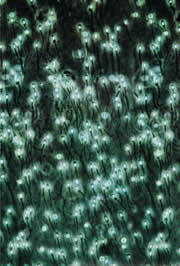 |
That
is God, your Lord. There is no god
but Him, the Creator of everything.
So worship Him. He is responsible
for everything. (Qur'an, 6: 102) |
|
Of the 300 million sperm cells that set out on
the road together, only the strongest one thousand
will succeed in reaching the egg. Out of these
only one single sperm will win the race and fertilise
the egg. Before entering this race, the sperm
first set out on a long journey within the male
reproductive organs, passing through various stages
on their way to maturity. In this maturing process,
the sperm have many helpers.
The Sperm's Developmental Pathway
 In order to fertilise an egg, about 200-300
million sperm cells are made ready for the journey.
This is a surprising number, but there is an important
reason for it. As we will see in more detail later,
a great number of the sperm that enter the mother-to-be's
body die on the way and the number of sperm which
are able to reach the egg is very small. Therefore,
the great number of sperm obviates the risk of
the fertilisation of the egg not being successful.
This army of millions of individual sperm is produced
in the male reproductive organs called the testes.
The sperm go through many stages in their production
in the testes and, in order for them to survive,
the place where they are produced must be cool.
The normal human body temperature is 37oC. This
temperature would kill the sperm, therefore sperm
cannot live inside the body. One of the most noticeable
characteristics of the testes is that they are
outside the body. Because of this special design
according to which God created the male body,
the sperm have a specially prepared place for
their production. In order to fertilise an egg, about 200-300
million sperm cells are made ready for the journey.
This is a surprising number, but there is an important
reason for it. As we will see in more detail later,
a great number of the sperm that enter the mother-to-be's
body die on the way and the number of sperm which
are able to reach the egg is very small. Therefore,
the great number of sperm obviates the risk of
the fertilisation of the egg not being successful.
This army of millions of individual sperm is produced
in the male reproductive organs called the testes.
The sperm go through many stages in their production
in the testes and, in order for them to survive,
the place where they are produced must be cool.
The normal human body temperature is 37oC. This
temperature would kill the sperm, therefore sperm
cannot live inside the body. One of the most noticeable
characteristics of the testes is that they are
outside the body. Because of this special design
according to which God created the male body,
the sperm have a specially prepared place for
their production.
The testes are composed of a system of small
tubes. This system of tubes occupies quite a large
space, which allows millions of sperm to be produced
quickly and in a place where they can be easily
stored. The reason that sperm must be quickly
produced and stored is understandable when we
consider that, for an egg to be fertilised, 200-300
million sperm must be produced.
When we think about the number of sperm produced,
we can call the testes miniature factories. For
sperm production they have almost 1000 small tubes
with a total length of approximately 500 meters.
These small tubes are called the "seminiferous
tubules". Each one of them is about 50 cm. long
and contains the primary sperm cells that eventually
produce the sperm.2
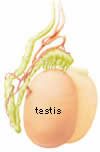 The male testes,
male reproductive organs, with their location
in the body, their reproductive capacity
and internal structure, are a wonderful
example of design.
The male testes,
male reproductive organs, with their location
in the body, their reproductive capacity
and internal structure, are a wonderful
example of design. |
| 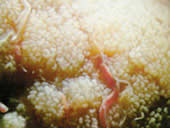
On the right,
we see the system of small ducts
that compose the testes (seminiferous
tubules). These small ducts contain
the primary sperm cells which
will later produce the sperm.
In the picture above, we see a
detail of the lobule of the testis.
|
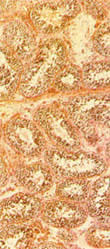 |
|
Seminiferous tubules are lined with sperm-forming
cells (spermatogonia) in various stages of development.
Later, these cells begin to multiply, first by
undergoing mitosis and then twice undergoing meiosis.
As we explained in the last section, before fertilisation,
the primary sperm cell undergoes division by meiosis
and lowers by half the number of its own chromosomes,
so that the baby will receive 23 chromosomes from
the father.
At the end of these divisions, four cells called
spermatids are formed which as yet have no ability
to fertilise an egg. In order for these spherical
cells containing 23 chromosomes, to be able to
perform their fertilising function, they must
go through further changes.
A group of cells has been put in place to respond
to this special need of the male reproductive
system and to assist the development of the spermatid
cells at precisely the right time. Within two
or three weeks after meiosis has occurred, every
spermatid cell will be physically transformed
by these "nurse" cells (Sertoli cells) which surround
them. Sertoli cells function to support and nourish
the immature sperm cells by giving them nutrient
material, hormones, and enzymes that are necessary
for causing appropriate changes in the spermatids.3
In the final stage of this process,
the qualities proper to a fully developed sperm
emerge the tail, the head and the acrosome, that
part of the head which is filled with enzymes.
(For detailed information see the section entitled
"The Sperm Meets the Egg")
All this work of transformation is performed
by the Sertoli cells found within the walls of
the tubules. These cells have cytoplasmic extensions
and are quite large. The Sertoli cells hold the
developing spermatid cells firmly in their arms,
assuring that they are well injected into their
own cytoplasm. In this way, they will provide
them with nourishment during their development,
and monitor them.4
In this process which we have briefly described,
a really great miracle occurs. The sperm which
assures the continuation of the human race is
brought into being, thanks to Sertoli cells, which
are made up of proteins and nucleic acids. Let's
think for a moment. The fact that a Sertoli cell,
rather a cell without intelligence or consciousness
and without eyes, ears or a brain, can devote
itself to such a duty is truly a wonder. The fact
that such a thing occurs is clear proof that the
cell is under the direction of a supreme intelligence.
Moreover, that these cells are exactly at the
proper place, (that is, in the seminiferous tubules
where the sperm develop,) and that they have exactly
the requisite qualities (for example, they are
larger than the spermatids) is one of the millions
of proofs of the perfect design of the human body.
God has placed every one of the approximately
100 trillion cells that make up the human body
in its proper place; He has given to each one
the qualities it needs; and He has given each
one the instinct to do its work perfectly. As
we are told in the Qur'an:
... There is no creature
He does not hold by the forelock. My Lord is on
a Straight Path. (Qur'an, 11: 56)
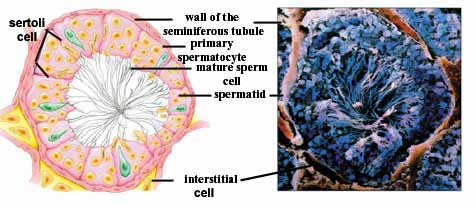
Seminiferous tubules, a detailed view
of the structure of which is above,
ensure sperm production. Right: a cross-sectional
view of the seminiferous tubule under
an electron microscope. Left: the structure
of a seminiferous tubule, showing developing
sperm cells in various stages.
|
An Interdependent System
In the preceding section we spoke about the role
of the Sertoli cells in the transformation of
the spermatids into the sperm. What is the physical
force that activates these cells and makes them
know their duty to nourish the spermatids and
monitor their development?
The impetus which makes the Sertoli cells perform
their function comes from the follicle-stimulating
hormone (FSH), which was mentioned in the earlier
section. This hormone is secreted from the anterior
pituitary gland and stimulates the Sertoli cells.
If this hormone is not produced or fails to reach
the relevant area, sperm cannot be produced. When
the Sertoli cells receive the stimulation, they
begin to secrete a hormone called oestrogen, which
is indispensable for sperm production. Another
kind of cell that influences sperm production
is called the "Leydig" cell; it is found between
the seminiferous tubules. These cells produce
another hormone required for sperm to develop.
The LH (luteinizing hormone) is secreted from
the anterior pituitary gland and stimulates the
Leydig cells. Then, these cells begin to produce
the testosterone hormone. Testosterone is the
hormone which assures the growth of the reproductive
organs, the development of various glands of these
organs and the development of the male sexual
characteristics; it is, moreover, the most important
hormone in the production of sperm.
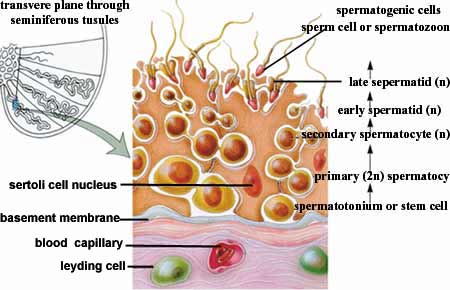
Development stages of the sperm in
the seminiferous tubule are as illustrated
above. Seminiferous tubules are lined
with sperm-forming cells (spermatogonia)
in various stages of development. Through
the process of division, these cells
form the cells called "spermatid". At
the final stage of these processes,
the head and the tail sections of the
sperm are formed. After all these complex
processes, the development of the male
reproductive cells, where the information
relevant to the human being is stored,
is completed.
|
The Sertoli cells have additional functions such
as protein production. This protein will carry
the oestrogen and testosterone hormones to a fluid
found in the seminiferous tubules.5
And the Leydig cells also have a second function.
In order for the sperm cells to move, they require
energy; the Leydig cells supply this energy by
the fructose they produce. (This important topic
will be dealt with in more detail later.)
As we can see, as in other parts of the body,
the hormonal system also performs in a perfectly
organized fashion in the reproductive system.
Every hormone immediately understands the message
carried by another and responds as required. For
example, the pituitary gland, when it knows the
time is right, goes into action and sends commands
to various cells in the testes informing them
of the job they must do in the organs and tissues.
Moreover, what stimulates the pituitary gland
into activity is a different area of the brain
called the hypothalamus.
The first stage of the formation of a human being
is concerned with the correct understanding of
the messages hormones carry and with the proper
execution of the commands. How do cells and molecules
discern and react to messages carried by hormones?
How do they know the chemical make-up of each
one and what methods must be employed to affect
them?
The fact that, in order to support the production
of sperm, the Sertoli and Leydig cells go into
action at the command of the pituitary gland (a
gland very distant from them, which they have
never seen and which has a totally different structure
from their own) combined with the fact these cells
would not perform any function at all without
these commands, makes it impossible to explain
their activity in terms of chance. It is impossible
that hormones have gained their special characteristics
as a result of a series of chance occurrences,
because a severance or an interruption during
one stage of the system will influence a whole
chain of processes. If one element in the system
is defective, the functioning of the whole system
is impaired. For example, if the Sertoli cell
does not know the meaning of the FSH hormone sent
by the pituitary gland and does not begin to secrete
oestrogen, sperm cannot be produced. Or, if the
Leydig cells cannot perform their function to
provide fructose, or if they produce it in insufficient
quantities, a sperm, even if it is mature in every
way, will die after entering the mother's uterus
because it cannot find nourishment; and because
it cannot reach the egg, fertilisation will not
occur.
This situation shows us a clear reality. The
One Who has established the connections between
the organs and the cells is God. He has inspired
the pituitary gland, the hypothalamus, the Leydig
and Sertoli cells, in short, every element involved
in the process, to act in a way that will assure
the production of sperm in the male body. He gives
them the ability to understand each other's language.
Everything happens according to God's command.
As we read in the Qur'an:
He governs all, from heaven
to earth... (Qur'an, 32: 5)
Other Structures that Help the
Sperm Reach its Target
| 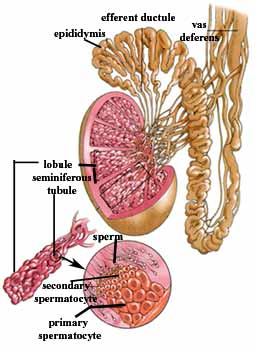
In the production
of sperm, several interrelated systems go
into operation in the testes. At the side
you see a section of the intricate interior
structure of a testis. Over and above the
complex structure of the human body there
is a flawless interrelation between its
organs and cells. The functions of the body
are carried out thanks to this interrelation.
Only one single part of this system made
ready for the production of a sperm is enough
for us to understand the perfection of the
body's structure.
|
Another element of the reproductive system called
the "epididymis" helps the developing sperm cells
acquire the ability to move and fertilise the
egg. The epididymis is loosely attached to the
outside of the testes; it is a coiled tube of
about 6 meters. Before beginning this part of
their journey, some sperm are stored for a while
in the epididymis. The sperm then move toward
a connective tube, the "vas deferens", a long
tube that ascends from the epididymis in the pelvic
cavity. The sperm can be stored in this tube for
a long time without losing their ability to fertilise
an egg, and when the time comes, the sperm leaves
the vas deferens and begins the long journey to
the egg cell in the female body.6
In order for the sperm to be able to begin the
function of fertilisation, they need other helpers
to supply what is required on this difficult journey
and to give the support they need to survive.
One of these helpers is the prostate gland. In
addition, there are two secretion glands called
the "seminal vesicles" located on each side of
the prostate. These glands begin their work of
producing special fluids to accompany the sperm
on their journey, when the production of the sperm
is complete.
A fluid secreted from the prostate gland joins
the sperm on their way. This fluid is composed
of citric acid, calcium and acid phosphate, a
clotting enzyme and a profibrinolysin. In the
female reproductive organs there is a thick mixture
of acids which prevents the proliferation of bacteria.
Besides curtailing the ability of the sperm to
move, this acid mixture can kill them, but the
prostate fluid neutralizes the effect of the acid,
thus allowing the sperm to swim easily toward
the egg.
Here it is useful to pause and think for a moment.
The prostate gland in the male reproductive system
acts with knowledge of the environment of the
female body. It knows that the sperm will encounter
an acidic environment in the course of their journey
and that they will not be able to survive in that
environment. Moreover, it can determine how to
overcome this danger and produce the fluid required
to do it. There is no doubt that here we have
to do with a miracle. It is impossible to say
that a secretory gland in the male body knows
another structure unconnected with itself, and,
acting according to this knowledge, makes decisions
and carries them out. Just think: not even a human
being with conscious intelligence and the ability
to hear and see, calculate, decide on a course
of action and arrive at a solution, could foresee
what kinds of danger exist in a totally alien
environment and take measures in relation to them.
But the prostate gland, a piece of flesh composed
of cells, can manage this. It is in no way possible
to claim that it is the prostate gland that makes
such vital decisions and implements them. It is
God Who has inspired this gland to perform its
function; it is He Who has created every square
millimetre of the male reproductive system and
of the female body.
Moreover, the prostate gland is not the only
gland that produces what is required in the male
reproductive system for the journey of the sperm.
The fluid secreted by the seminal vesicles located
beside the prostate gland is indispensable for
this journey. Shortly after the sperm have started
on their way, this fluid joins them to help them
reach the end of their difficult journey. This
fluid contains an abundance of fructose and other
nutrient substances as well as large quantities
of "prostaglandins" and "fibrinogen". The fructose
and other nourishment sustains the sperm from
the time it enters the female body to the time
it fertilises the egg. In addition, the "prostaglandin"
in this fluid helps the sperm to reach the egg
in other different ways. One of the functions
of prostaglandin is to react with the mucous in
the uterus channel and provide a suitable environment
for the movement of the sperm. A second function
is to cause reverse contractions in the uterus
and fallopian tubes to allow the sperm to move
more easily.
At this point it is again obvious that we are
confronted with a very great wonder. The fluid
secreted by the seminal vesicles perfectly knows
the intricate structure of the female body which
it has never seen. It knows in advance that the
reverse contractions in the uterus and fallopian
tubes will help the movement of the sperm and,
acting with a high degree of foresight, it adds
a chemical material (prostaglandin) to its own
make-up that will bring about these contractions.
Think of asking any chemist to produce such a
reaction; what would he do?
First he would examine the sperm, its structure
and the requirements for fertilisation to occur.
Later he would try to learn about the female body,
its hormones, the egg, the fallopian tubes which
carry the egg to the uterus, the uterus, the tissues
of the uterus, the nerve system that causes the
contractions and many other details. Then, combining
his years of education and experience he will
discover the material substances which exert an
influence on these things; he will take them,
and by way of experiment and research he will
find out in what proportions these substances
must be combined. A human being possessed of consciousness
may perhaps be able to do this with a lot of devoted
and time-consuming effort.
| 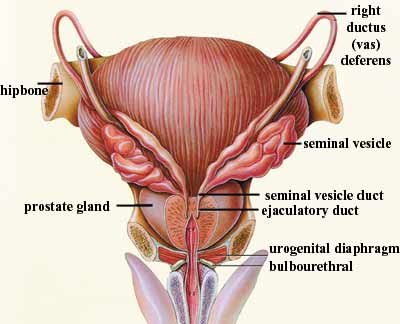
The fluid secreted
by the prostate gland (above) is extremely
important in the production of sperm. Because
of this fluid, the fatal effect on the sperm
of the acid mixture in the female reproductive
organs is neutralized. The fact that this
fluid produced in the male body has a quality
to enable it to neutralize the negative
effects of a fluid produced in another body
is a proof of God's incomparable creation. |
However, what accomplishes these things is not
a chemist who has become an expert in this field
after years of study. It is cells, tissues and
organs produced by unconscious atoms and molecules.
All the same, it is not possible to assert that
this collection of cells has a higher intelligence
and a greater knowledge than a chemist, or that
they perform these functions at the bidding of
their own will.
There is no doubt that this fluid produced in
the male reproductive system and designed in such
a way as to influence the female reproductive
system, together with the cells, tissues and organs
that produce it are a clear proof of God's creation.
It is evident that this whole interrelated system
cannot be the work of chance. A person of intelligence
and conscience will immediately grasp that these
wondrous occurrences that happen flawlessly in
the bodies of every human being that has ever
lived are the work of a supreme intelligence and
an eternal power, and he will serve God, to Whom
alone belongs this eternal intelligence and power.
O mankind! Have fear of
your Lord Who created you from a single self and
created its mate from it and then disseminated
many men and women from the two of them. Heed
God in Whose name you make demands on one another
as well as any ties of kinship. God watches over
you continually. (Qur'an, 4: 1)
A Fluid with a Complex Structure:
Semen
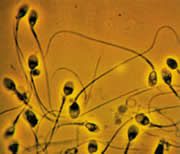 In this picture
we see sperm moving in seminal fluid.
Seminal fluid is a mixture of fluids secreted
by various glands. Contrary to popular
opinion, of all the components of this
complex fluid, only the sperm has the
ability to fertilise. This scientific
fact-only recently discovered-was revealed
in the Qur'an 1,400 years ago..
In this picture
we see sperm moving in seminal fluid.
Seminal fluid is a mixture of fluids secreted
by various glands. Contrary to popular
opinion, of all the components of this
complex fluid, only the sperm has the
ability to fertilise. This scientific
fact-only recently discovered-was revealed
in the Qur'an 1,400 years ago.. |
When the sperm begins its journey, the prostate
gland secretes a fluid and immediately afterwards
another fluid comes from the seminal vesicles;
they join the sperm and semen is produced. All
together they travel towards the mother's body.
As we described earlier in detail, the function
of these fluids is to have the nourishment ready
to provide the energy that the sperm need, and
particularly to neutralize the acids at the entrance
to the mother's uterus, making an environment
in which the sperm can move more easily.
The whole of this fluid which is ejected from
the male body for the process of fertilisation
is called semen. 10% of it comes from the sperm
canals, 60% from the seminal vesicles, 30% from
the prostate gland and the rest is sperm cells
and a small quantity of fluids from other secretory
glands.7 That
is, what we call semen is a complex combination
of fructose, phosphorylcholine, ergothioneine,
ascorbic acid, flavins, prostaglandins, citric
acid, cholesterol, zinc, acid phosphatase, lactic
acid, fibrinolytic and proteolytic enzymes, hyaluronidase
and sperm.8 We
have before our eyes a wonder that God has revealed
in the Qur'an.
In many places in the Qur'an God calls attention
to human creation and commands us to think about
this matter. Scientists who have investigated
these verses of the Qur'an have discovered that
a number of wonders of the Qur'an are hidden in
those verses that give information about human
creation. For example, it has been discovered
in research done with the help of modern scientific
technology that semen is composed of a mixture
of different substances. But this information
was made known in the Qur'an 1400 years ago. Semen
is described as a "mingled" drop in the Qur'an:
We created man from a mingled
drop to test him, and We made him hearing and
seeing. (Qur'an, 76: 2)
Of the components which make up this fluid, only
one sperm fertilises the egg. A large number of
people think that the semen as a whole does the
fertilising; however, only a small part of the
semen, a sperm, does this. That is, a human being
comes into being not from the semen as a whole,
but from a small part of it (the sperm).
In the course of sexual union, along with the
semen, about 250-300 million sperm are ejaculated
from the male. But out of millions of sperm, only
about 1000 manage to reach the egg and of these
1000, the egg will only receive one. That is,
the essence of a human being is not contained
in the semen as a whole, but just in a small part
of it. This fact, about which many people either
have no knowledge or are misinformed even today,
was revealed in the Qur'an 1,400 years ago. The
Qur'an explains this reality in these words:
Does man reckon he will
be left to go on unchecked? Was he not a drop
of ejaculated sperm? (Qur'an, 75: 36-37)
In another verse, it is indicated again that
semen is a mixture and humanity is created out
of the "extract" of this mixture.
He has created all things
in the best possible way. He commenced the creation
of man from clay; then produced his seed from
an extract of discarded fluid. (Qur'an, 32: 7-8)
If we examine the meaning of the Arabic in this
verse, it becomes clear that we are confronted
with a wonder of the Qur'an. The English word
"extract" translates the Arabic "sulala"; and
means the essence or the best part of a thing.
By either implication, it is "a part of a whole".
This shows clearly that the Qur'an is the word
of a Will that knows about human creation down
to the finest detail. This Will belongs to God,
the Creator of human beings.
Final Preparations Under
Way...
Now the general appearance of the sperm, supported
by the fluids in the semen, has become evident.
Every part of the sperm the head, the neck, the
midpeace, the tail and the end piece all have
their separate functions.
The nucleus (the head section) is no larger than
5 microns. In this 5 micron space has been placed
all the information relevant to the human body
and required to turn one cell into a human being.
In the head of the sperm is a genetic package
of 23 chromosomes which will be carried to the
egg. That is, in the head of the microscopic sperm
cell has been safely packed the information about
how all the organs of the human body will work,
where they will be located, at which stage which
cells will begin to develop and change, in short,
all the information about how the human body will
be constructed.
Along with the genetic information, the head
of the sperm has another special feature. For
example, in the "acrosome", the name given to
the outer protective layer of the head, there
are substances which will help the sperm in the
final stages of its journey. These are enzymes
which can dissolve tissues. Using these enzymes,
the sperm will be able to pierce the egg and enter
it during the process of fertilisation.9
(see "The Sperm and the Egg
Meet")
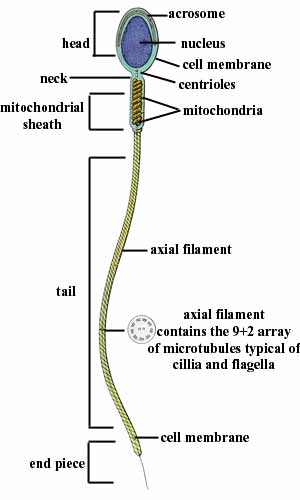
Every section
of the sperm has a different function.
If the sperm had no tail, it could not
move; if there were no mitochondria
in the midpiece, the sperm would produce
no energy and would remain immobile;
if there were no acrosome in the head
section of the sperm, there would be
a deficiency in some enzymes, making
it impossible for the sperm to pierce
and fertilise the egg. This shows that
the sperm could not have been produced
by chance over a period of time, stage
by stage. The perfect design of the
sperm comes from God.
|
The second most important part of the sperm is
the tail, which allows it to swim easily in a
fluid environment. The sperm's tail determines
the direction in which it will swim and helps
it to reach the egg cell. So far so good. But
how does this tail supply the energy needed for
the sperm's continual whip-like movements? The
energy needs of the sperm are supplied in a wonderful
way. The body of the tail is a fuel depot, which
supplies energy throughout the journey. On the
long road until it reaches the egg, the sperm's
need for energy is met by the mitochondria found
in this section. Using the energy carriers in
the neck of the sperm, the mitochondria supply
ATP energy, which allows the sperm to move easily.10
As we can see, in all of its aspects the sperm
displays a perfect design. Without the tail, the
sperm would not be able to move; without the mitochondira
in the midpeace, energy could not be produced
and again, there could be no movement. If the
head section of the sperm were structurally perfect
except for a missing acrosome, the required enzymes
would not be produced and there would no longer
be any purpose in the sperm reaching the egg;
it would not be able to penetrate the egg cell
and fertilise it.
Therefore, the sperm cannot have acquired all
these features by stages in the course of time
as the theory of evolution claims. When the first
human being appeared in the world, the sperm must
have contained all these features. Since it would
be impossible for the sperm to perform its fertilising
function with a deficiency in any one of these
features, and if, as the evolutionists claim,
there had been sperm in the past that did not
possess all of these features, human beings would
not have multiplied; they would have been wiped
off the face of the earth. This shows that sperm
came to be in one moment with their perfect structure;
that is, it demonstrates the fact of creation.
The Creator of the perfect design of the sperm
is God, the Creator of everything.
| The Head of the Sperm is Covered With Protective
Armour |
 |
 |
In this illustrations
we see the head of the sperm covered
with armour. In the head section
of the sperm are located the nucleus
and various dissolving enzymes.
In order to protect this valuable
cargo from danger on its long journey,
the head section of the sperm is
covered with armour (1-2). After
being covered, the heads of the
sperm are placed in protective casings
and sealed. (3-4-5-6). The sperm
continue their journey in safety
protected in this casing which contains
the nucleus, 5 microns in size,
and containing all the information
relevant to the human body. Also
protected in this casing are the
dissolving enzymes which will pierce
the egg at the beginning of the
fertilising process. This is only
one of the stages in the production
of the sperm. After this, the sperm's
motor and tail section are "mounted"
separately and a wonderful work
of engineering is the result. So,
at this point, we must again consider:
How do unconscious cells learn how
to construct something and put it
into production? Given the fact
that they have no knowledge of the
mother's body, how do they know
how to make the sperm ready for
it? There is only one answer to
these questions: God, Who has created
all things, has designed and creates
the sperm. |
 |
 |
| 
|

|
|
Systems Created for Each Other
When the sperm leave the male body in the semen,
they are not completely ready to fertilise the
egg. Until they leave the male body, their movement
is controlled by basic secretions in the area
where they are stored. For this reason, when the
semen is first formed and reaches the female body,
the sperm cannot perform their fertilising function.
How, then does it come about that the sperm, when
separated from the male reproductive system, acquire
the ability to fertilise the egg?
In order for the process of fertilisation to
be facilitated, a number of systems in the female
body must be made ready. At this point, some fluids
secreted in the female reproductive system come
to the help of the sperm by increasing the sperm's
ability to fertilise the egg. These are some of
the changes that take place in the sperm after
they reach the female body:
 1. The fluids secreted in the woman's uterus and
fallopian tubes contain a chemical that destroys
those factors that retard the movements of the
sperm in the male reproductive tract. In this
way, the movement of the sperm that reach the
female reproductive tract is increased. 1. The fluids secreted in the woman's uterus and
fallopian tubes contain a chemical that destroys
those factors that retard the movements of the
sperm in the male reproductive tract. In this
way, the movement of the sperm that reach the
female reproductive tract is increased.
2. The fluids in the male reproductive tract
(seminiferous tubules, in the epididymis, and
in the vas deferens) all contain a high level
of cholesterol. The cholesterol is continually
donated to the cellular membrane covering the
acrosome, toughening this membrane and preventing
release of the enzymes prematurely. But from the
point of view of the sperm's ability to fertilise
the egg, this particularity is detrimental. For
this reason, the sperm which pass into the female
body must be rescued from its effects. As in the
millions of details in the stages of human reproduction,
a special system has also been prepared for this
purpose. The sperm, which enter the female body
later join the fluid in the uterus. And this fluid
reduces the level of cholesterol contained in
the semen, which also contains the sperm, thereby
making the head of the sperm (acrosome) more fragile.
So, when the sperm reaches the egg, the enzymes
inside the acrosome can come out easily and will
assure the fertilisation of the egg by their penetration
of the egg membrane.
3. The permeability of the membrane in the head
of the sperm which enters the female body increases
in relation to calcium ions. With the entrance
of a great quantity of calcium into the sperm
cell, the movement of the sperm increases. The
whip-like tail (flagellum) which causes the movement
of the sperm changes its former weak undulations
and begins to make strong movements, thereby facilitating
its ability to reach the egg.11
Without doubt, for those who think carefully,
there are very important indications to be found
in the creation of the sperm in such a way as
to be so harmonious and complementary to the female
body. The fact that the sperm and the female body
cooperate to bring about the same miracle, independently
of each other, is indicative of a great conscious
intelligence. The sperm, before entering the female
body and while they are still in the male body,
take measures to produce what is required to correct
their deficiencies that might create problems
for them in the female body. A special environment
is prepared in the female body to increase the
movement of a single sperm that is even too small
to be seen by the naked eye. It is as if the female
body knew that the sperm's journey would be very
long and that it would need energy to complete
it quickly; it is as if it knew what kind of chemical
composition would penetrate the egg, guessed that
the sperm had deficiencies in this regard and
determined that cholesterol was the cause of them,
and then produced something to neutralize the
cholesterol, thus producing an environment in
which the egg could most easily be penetrated.
And it would do all of this on its own!
It should be remembered that what is summarized
above is merely a small part of the steps from
the sperm's entrance into the body to the fertilisation
of the egg. These steps are completed as a result
of thousands of ever more complex chemical reactions
in which several proteins, enzymes and fluids
are also involved. But it is especially important
to remember that it is not our intention here
in enumerating these details simply to impart
scientific knowledge; our intention is to point
out the truth that, contrary to what the evolutionists
claim, the formation of a human being is too complex
ever to have been the product of blind chance:
it is the result rather of the flawless operation
of complementary, interdependent and intricate
systems. It is not possible for a human being,
or even one single enzyme or molecule that activates
the sperm, to come into being by chance.
On this point we have talked about how a sperm
cell produced in the male body acquires the ability
to fertilise an egg with the help of chemical
substances in the female body. Now let's pause
and think: Could such a complex system come into
being in stages by chance as the theory of evolution
claims? Certainly, such a thing is impossible,
but once more let us consider such a scenario.
A sperm produced by chance in the male body first
comes into contact with a female body. Would it,
as a matter of chance, find the fluids that allow
the sperm to acquire its ability to fertilise,
all ready and waiting for it? If not, upon the
failure of the first sperm reaching the female
reproductive system to perform its fertilisation
function, would the female reproductive cells
make a decision and begin to produce the required
chemical substances?
It is beyond doubt that these two examples do
not accord well with logic or intelligence; they
are scenarios that could never happen. In the
examples we have given on this point, one truth
confronts us: all these systems are each a proof
of the endless knowledge and power of God Who
created everything. God has created in the depths
of the human body wonders that are too small for
the eye to see and beyond the capacity of the
human mind to comprehend. By this, He points out
that there are proofs for faith that occur in
the body, which are totally independent of human
will and knowledge. And He reminds us that His
dominion is over everything, including human beings
themselves.
Truly, your Lord is vast
in forgiveness. He knew you well when He created
you of earth, and when you were embryos in your
mothers' wombs. So do not claim purity for yourselves.
He knows best those who guard themselves against
evil. (Qur'an, 53: 32) |
